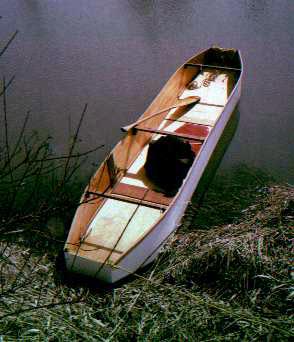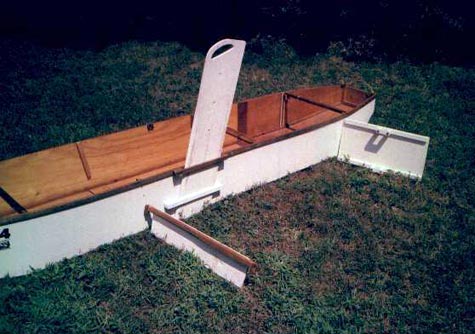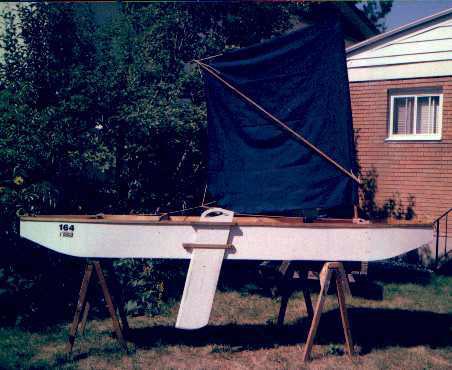| 
Late one winter an 11x2x1 punt was built
for the annual Jock River canoe race. The Jock is
a small river in Ottawa completely navigable only
during spring runoff.

Here we are waiting for the race to
start. More photos of the race can be found on the
website.
I got the punt out of the starting
gate in the third batch so it was not the last boat
to cross the finish line. Short boats generally finish
last.

During construction 25 pound weights
were used to hold the bottom down while it was fastened
to the chines, as shown in the above reenactment.

The punt was built in a second storey
bedroom and launched off a stepladder using a couple
of 10 foot boards for a ramp.

The punt was built as a cheap substitute
for a solo canoe. One 4x8 sheet of plywood was cut
into 2 feet for the bottom leaving twice 1 foot for
the sides. Another 4x3 foot scrap was cut the same
and butt joined to make the boat 11 feet long. Triangles
measuring 6" x 18" were cut off the corners
and rounded with a sander to pull in the ends. The
boat is held together with wood screws and polyurethane
construction adhesive (LePage's Bulldog brand PL Premium
in the caulking tube). It weighs 35 pounds and draws
about one inch of water, ideal for exploring shallow
rivers and lifting over obstructions.

The challenge is to get a shallow flat
bottom boat to paddle straight. Note how the red kneeling
pad is set over to one side to sink the chine into
the water. That provides the "bite" that
makes the boat paddle straight. In very shallow water
one knee is shifted over to the other side to flatten
the boat and reduce the draft.

A simple removable sailing rig was added.
The mast fits into a bulkhead which slides into slots.
The bulkhead keeps the sideways force of the mast
from distorting the boat's shape. The other piece
is a backrest. For simplicity there is no rudder.
The boat is steered by adjusting the sail and shifting
the sailor's weight side to side. For hard turns the
paddle is shoved into the water. Notice the small
black spirit level fastened to the inside of the gunwale
opposite the daggerboard. The level shows when the
boat is not in trim so the sailor can adjust his weight
to keep it in trim. For fussy sailors, every little
bit of speed counts.

Both the sail and the daggerboard are
off another boat. All three small sailboats I made
use the same daggerboard. Colour me lazy. When the
boat heels over going upwind the chine provides enough
bite to go straight, same as when paddling. It took
a while to find the balance point to mount the daggerboard.
I spent a long time moving it back and forth on the
hull before finding the "sweet" spot. When
going downwind the hull is flat and slews around a
lot, broaching in every little gust. A rudder would
help here but next season I'm going to try trailing
a line off the stern to dampen the motion. Even when
sailing upwind the boat is very sensitive to wind
shifts. I had to a mount a telltale on the bow transom
to get a sufficiently good reading of the wind to
make headway. Sailing the punt takes concentration.

The punt spends the winters sleeping
in my basement.

|